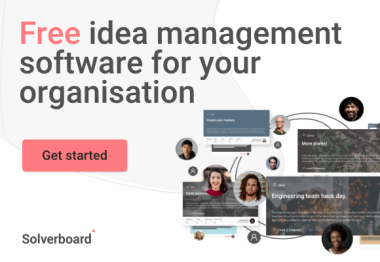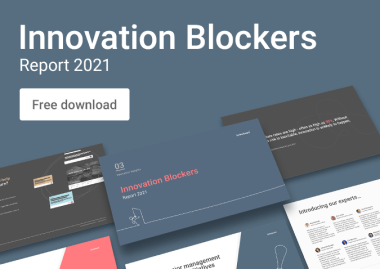Methods of measuring innovation: using failure to fuel success
by Aaron Slater, on 18 Jun 2020 4 min read

Ex-R&D Director for an international technology company, Paul Northey, shares the challenges he faced trying to transform company culture in accepting failure as a positive means of measuring innovation success.
Research collated for our Innovation Blockers report reveals that measuring and proving the value of innovation to others and getting senior management to support new initiatives are among the biggest challenges’ businesses face with innovation.
Trying to quantify success in terms of return on investment (ROI) or justify associated budget costs is often impossible when you are trying to do something implausible or unmeasurable in your industry. One of the major challenges is to bring the finance organisation on board, how much will you be spending and how much will it return? Typically, the engineering staff need no explanation of the value as the activity brings fresh interest and allows for exploration.
To continue this conversation, we caught up with Paul Northey, to share his fascinating approach towards addressing these challenges while trying to roll out Innovation culture in an organisation.
Getting the board on board
Before businesses can go about creating and measuring innovation, they must overcome the challenges surrounding the topic at a senior level. Innovation programmes can take significant budget without an immediate hard-tangible output.
This is ultimately the crux of the problem. What exactly is the payback?
For Paul, it’s both the obvious – new product development, potentially higher profitability, innovative products have higher margins – and the not so obvious – improved staff satisfaction, higher staff retention, intra- and inter-site interaction and communication, and higher efficiency.
The task is to persuade senior management using a broad range of paybacks, and challenge mindsets that simply believe it isn’t worth the risk; remembering there are always short term demands on resources that could have a higher priority.
In Paul Northey’s case, it was a gradual process of introducing the idea of innovation and starting the conversation at every meeting. Teaming up with other development sites and building a core of support.
“Part of the process was trying to get senior management to understand that part of the process of measuring innovation is accepting failure.
Businesses can often view failure in its literal sense and discard an idea if it doesn’t generate an instant return on investment. However, failure is an essential part of exploration in fuelling growth and discovery.”
It took Paul 12 months to get agreement to support the idea of innovation. The game-changer was the introduction of a framework.
“Instead of coming up with a stringent plan to use at every site and location, which is counterproductive to creativity, I created a loosely driven process where we gave our engineers a % of their working week to develop new, innovative ideas.
“They could use this time to work on something independently or form a small team to develop an idea. They would then fill out a simple one-page form explaining the idea, what it meant to people and some indication as to what the financial return would be if it was a success. Every idea was then reviewed by a small panel, the activities would then be reviewed monthly and a 'Continue, Stop or Move to next stage' status applied.
“The mission statement would state we would, every five years you’d find a revenue stream that would pay back the investment on Innovation. One-third of investments would be reserved for ideas that were a bit blue sky, another third for ideas that are aligned to the existing marketing and the final third to concepts that were associated with different business opportunities.
“It’s a bit like going to the races. Sometimes you’re going to win and other times you’re going to lose. But ultimately, if you don’t keep doing it, you’ll never win big.”
Developing an all-encompassing innovation measurement system
One of the major blockers in innovation is that the strategy doesn’t always translate to actionable plans. It’s a case of businesses defining what is meant by ‘innovation’ and what the outcomes should look like.
There’s no blueprint on how to measure innovation. Every innovation leader must show decision-makers a way of working and verify how the results recorded resonate with the sustainability of the organisation.
Paul recognised the importance of finding a happy medium between finance, creativity, and resource priority.
“Most businesses can’t afford to make the same exploration investments as Apple, Google and Facebook.
“For most, you have to think about the balance sheet and how the finance director perceives this. They have a very different vision than engineers; without their support you will eventually fail.
“I also put lots of mechanisms in place to ensure the priorities were clear, the communication was clear and the process was clear. We ensured we had clear gates for progress.”
It serves as a stark reminder that an organisation’s mindset and its ability to see failure as a learning curve is an integral part of developing a long-term innovation measurement system. Plus, the importance of return on investment, especially regarding SMEs with a limited budget, will always prove to be one of the biggest blockers of innovation.
“My advice for any innovation leader would be to really engage with the finance department and senior management, and develop workshops so that there's a sense of participation and sign up…
“You need people in leadership positions to really focus on the vision and to keep it growing, a structured gating process with broad sign off is essential.
“The key is to get an organisation to accept the likelihood of failure and see the positive effects it has on driving future success, communicate and measure the indirect and direct benefits of innovation, be clear and champion innovation success.”
Continue the conversation
Paul Is now MD of Links Global Tech, an agency supporting innovative technical companies find the best talent. We thank him for speaking to us and sharing these valuable insights on overcoming fixed mindsets and his approach of using failure as a means of driving future innovation. You can find further interesting ideas and ways of measuring innovation in our Innovation Blockers report.
Or if you’re keen to discover how Solverboard can help your business innovation moving forward, sign up for early access to our all-in-one innovation measurement system today.


